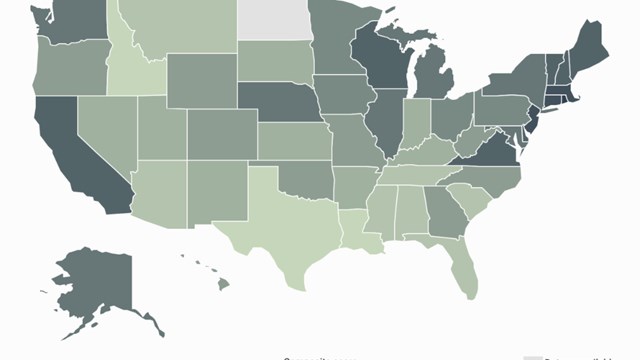The population of the United States is graying. Between 1990 and 2000, the number of Americans aged 60 and older grew by almost 4 million. Improved health care and resources are enabling people to lead longer, healthier lives, forcing many co-op and condo buildings to confront the issues of an aging ownership. In complexes where at least 50 percent of the residents have one family member over 60, a growing elderly population may now require specialized support, services and facilities that may not have been planned for when the typical population of the building, and even the building itself, was much younger.
A 1997 study found that that the overwhelming majority of seniors - 89 percent - live in their own homes and wish to stay there. Locally, the proportion of New York City seniors, aged 85 and over - the nation's fastest growing group of seniors - has increased by 19 percent in the past decade.
The decision to forego retirement options such as planned senior housing or assisted living facilities is now called "aging in place." And the phrase "naturally occurring retirement community," - "NORC" for short - was coined in the 1980s by sociologist Michael Hunt and his colleagues at the University of Wisconsin-Madison. Originally, the acronym referred to neighborhoods that were not planned for, but attracted, older immigrants. Lobbying by groups concerned with the provision of services to graying Americans has brought national attention to this unique community.
Officially, the NORC designation now connotes a community that is bringing in necessary social services, and receives government funding to better address the needs of older residents. Recently, the term has been used to refer to any group of elderly individuals, who are living as a community in the framework of the entire residential population of one or more buildings. A report by the American Association of Retired Persons (AARP) described NORCs as "the most dormant and overlooked form of senior housing."
The first NORC services program in the nation developed in New York City in 1986, at the Penn South Co-op complex in Chelsea. The International Ladies Garment Workers Union built the 2,800"“unit complex in 1962. Designed as a social experiment in providing affordable cooperative housing for moderate-income workers, the 10 twenty-one story buildings were dedicated by President John F. Kennedy. Many of the original residents - who once walked to work in the nearby garment center - chose to stay in New York after retirement. By the early "˜80s, 70 percent of the shareholders in the complex were over 60.
According to Nat Yalowitz, president of the Penn South Program for Seniors, "The board looked around and noticed the aging population. People were expressing a need for help." The board began looking at what social services the residents needed, then consulted with professionals to find a way to implement the plans. Community rooms and offices were established in several of the buildings. Health and social services providers were then contracted to bring in programming like counseling, case management, and referrals to available services such as Medicare and other entitlements. Many of the building's residents - young and old - volunteered as well.
Sixteen years ago at its inception, Penn South's program was privately funded by The Goldsmith Foundation, which contributed $500,000 for the first two years. Now close to $700,000 a year is needed to keep the programs up and running, Yalowitz explains. The New York State Office for the Aging provides $143,000, the city of New York, $140,000, and the cooperative itself chips in $125,000 from its operating budget to subsidize the NORC-related programs, according to Yalowitz. Federal grant subsidies also fund programming and additional funding comes through voluntary fundraising efforts and from private organizations such as the United Jewish Appeal Foundation (UJA), he adds. Yalowitz is currently seeking a federal grant to establish a safety education program to alert elderly residents to the dangers of slip and fall injuries.
Penn South has a nurse available on-site every day, recreation programs, discussion groups and card-playing leagues, exercise classes, financial counseling, social workers, and legal assistance for residents. Health professionals are provided by two hospitals, which rent space in the complex for geriatricians. "The advantage to having the services right here," says Yalowitz, "is more than just eliminating traveling. The physician can refer a patient to recreation classes, and vice versa. If a woman feels dizzy at her bridge game, she can go right away and get her blood pressure checked."
The services though are not only for seniors but are intergenerational, says Yalowitz. For example, Penn South holds an annual arts festival, conducts programs in its community garden on planting techniques and raising vegetables and flowers, and offers quilting classes in which the seniors teach young children how to quilt.
Anita Altman, deputy managing director of the UJA's Department of Government Relations and External Affairs, is deeply involved in the organization's grant-making activities. Back in 1988, she visited the Penn South program, which UJA was helping to fund. "This began as a purely philanthropic investment," says Altman. "Immediately, I began thinking, "˜how in the world were we going to sustain it?' No foundation funds something into perpetuity." Altman realized that older people were not prepared to pay for services by the hour, and the $50,000 from the co-op was not enough to support a program that cost $300,000 a year.
The UJA procured a Robert Wood Johnson Grant in order to replicate the Penn South program at Co-op Village and Amalgamated Warbasse in Brooklyn. "We were able to argue to the community and co-op boards that they directly benefited from the program," Altman recalls. NORC programs provide older residents with a wide repertoire of social services they need as they mature into their golden years. Seniors might forget a doctor's visit and come to rely on visiting social workers or on-site nurses to address their health needs. Recognizing the benefits to their community at large, co-ops began to kick in more and more funding to NORCs.
In 1994, New York became the first state to establish funding for NORCs through a bill sponsored by Assembly Speaker Sheldon Silver. The original program provided $1 million dollars in matching funds to eight NORCs in New York City and two in upstate New York. In order to qualify for up to $150,000 in state money, the housing corporation must be a partner along with foundation grants to supply up to 50 percent of the program budget.
In 1999, New York City put $4 million dollars into the budget to help fund NORC programs. The city follows the same matching formula as the state, but gives up to $200,000. Altman credits then City Council president Peter Vallone with creating the funding, which supports 28 metropolitan sites. Of the 28 local sites receiving government money, seven are in New York City Housing Authority (NYCHA) building complexes, two or three have private landlords, and the rest are moderate-income co-ops. The programs today reach 46,000 seniors. UJA is currently lobbying for a national NORC initiative, which would provide seed money to other cities.
Where UJA has been influential in fundraising and lobbying efforts, The United Hospital Fund (UHF) coordinates the partnerships between the community, philanthropic organizations, and supportive service providers. Recognizing the need for new approaches to providing care for seniors, UHF established the Aging In Place Initiative (AIPI) in 2000. AIPI provides expert technical assistance to the 28 NORC-supportive service programs in the city. The initiative leads a funding collaborative for the city's programs, coordinating nearly $600,000 annually in grants, including its own contributions. The AIPI is also a source of information about NORC programs and works to advance public and professional understanding of aging in place, and the needs of seniors.
Sophie Buccholz, board member of Amalgamated Warbasse Cooperative in Brooklyn, was influential in formulating their NORC program and recently experienced it's benefits firsthand. "For me, the program has been very supportive," says Buccholz. "My husband and I were very active. When he died last year, I didn't have to go outside for help. I had my people right here."
The NORC social services program at Amalgamated Warbasse recently celebrated its eighth anniversary with a party. "We had a deli dinner and entertainment," says Buccholz. "It was great to see so many people out and enjoying themselves. Where else can anybody be so involved and not be a shut-in?" A vast array of classes takes place all over the 2,585-unit co-op. The program has two vans - including one with a chair lift - to transport residents around the complex and on trips to shopping areas, museums, and movies. The visiting nurse that does blood pressure testing sees up to 300 people a week. "She has kept a lot of people out of the hospital," says Buccholz.
Robert Weisenfeld, publisher of the senior-focused Life Ahead newsletter, notes that the decline in interest to live in nursing homes and assisted-living facilities was partly due to media exposés of unhealthy - sometimes abusive - conditions in such facilities. Secondly, more empowered seniors expressed a strong wish to remain independent and active in their chosen communities.
"NORC means you are living where you have always lived," says Weisenfeld. "Moving to a [nursing or assisted-living] facility means a whole new environment, new people, new policies. And they're expensive." While establishing a co-op as a NORC may mean an increase in monthly maintenance, for most people this is vastly less than the $3,000 a month that most senior housing costs.
While larger buildings like Penn South have their work cut out for them, smaller buildings with aging residents have to face the problem of simply not having enough people to qualify for many of the state-funded NORC benefits. The West Side NORC program, consisting of St. Martin's Tower, 65 W. 90th Street, Columbus Park Towers, 100 W. 94th Street, and Strykers Bay, 689 Columbus Avenue, on the Upper West Side, is the first NORC cluster program in the city, according to Erika Teutsch, program director at Goddard-Riverside Community Center. Unlike large housing compounds like Penn South or Morningside Gardens, West Side NORC brings the benefits of a NORC program to a cluster of small buildings with large numbers of elderly residents, Teutsch says.
This partnership provides the collective clout needed to receive funding and also brings new ideas, new neighbors, and new friends into the mix. Funded through the New York City Department of Aging, and financial contributions from the three buildings and a pair of private foundations, with Goddard-Riverside as the service provider, West Side NORC has been in operation two years, says Teutsch. The program provides not only community and social well-being but also financial and legal assistance. Part-time social workers are on hand five days a week to assist the residents with problems relating to their health care, entitlements and insurance, budgeting and financial planning, and referral to needed social services, according to Teutsch. "The NORC program also includes a regular schedule of activities, including exercise, computer classes, drawing and writing classes, current events discussion groups, and speakers on special topics of interest. Social events such as lunch parties and movie nights, planned and implemented with the help of residents from the three buildings, help to enrich the quality of life for members of the buildings, many of whom live alone, with no family or families far away," Teutsch explains.
For buildings considering establishing social service programs, the NORC Supportive Services Center at Penn South can be a useful resource. Yalowitz oversees the Center, which was established five years ago to consult with fledgling programs in cities across the United States. Outside of New York, all the programs are 100 percent privately funded. High-income communities in the metropolitan area would also need to follow their model, as government support currently has income limitations. According to Weisenfeld, a building desiring NORC status fills out a long questionnaire - 20 to 50 pages - detailing demographics, income, ethnic backgrounds, and age details. It's important to know how many people are over 60, over 70, etcetera, to determine what social services are needed. To qualify for New York State funding, a NORC must have at least 50 percent of its households headed by someone over 60, or 2,500 residents that meet the age requirement. The city criteria requires 45 percent of households to be occupied by an individual 60 or older, or at least 500 residents in the age range. Smaller buildings can connect with others in the area in order to qualify. The NYC Department of Aging and UHF are other sources of information.
The advantages of an on-site social support program are many. Each program is customized for its community. Seniors who might be isolated have easy access to programs. The building will benefit from knowing that its' shareholders are taken care of. In co-ops that financially support a NORC, proponents say that people are more likely to be invested in the success of the program and the building at large. Many NORCs have seniors volunteering in capacities such as childcare or gardening that benefit other members of the community. "You can live where you are most comfortable," says Weisenfeld, "and have the convenience of on-site services. Why would anyone want to leave?"
As for how NORC status impacts overall building demographics, while being a NORC may attract older buyers, Yalowitz finds that new people moving into Penn South represent all age groups. In fact, the percentage of senior residents has dropped from 70 percent in 1986 to 64 percent now.
Weisenfeld feels that NORCs will be a dominant form of senior housing in the next ten years. He encourages property managers and co-op boards to become enlightened now about the needs of their senior residents. "The courts will come in and protect the rights of senior consumers," stresses Weisenfeld. "When property managers are not enlightened, they may find themselves facing lawsuits requiring them to build ramps or sliding stairwells. Co-op owners don't want to be left out of the loop. They have to get this to a vote and get managers enlightened now." Given the obvious benefits, it makes sense to lend support to the entire building community - the young and young-at-heart.






Leave a Comment